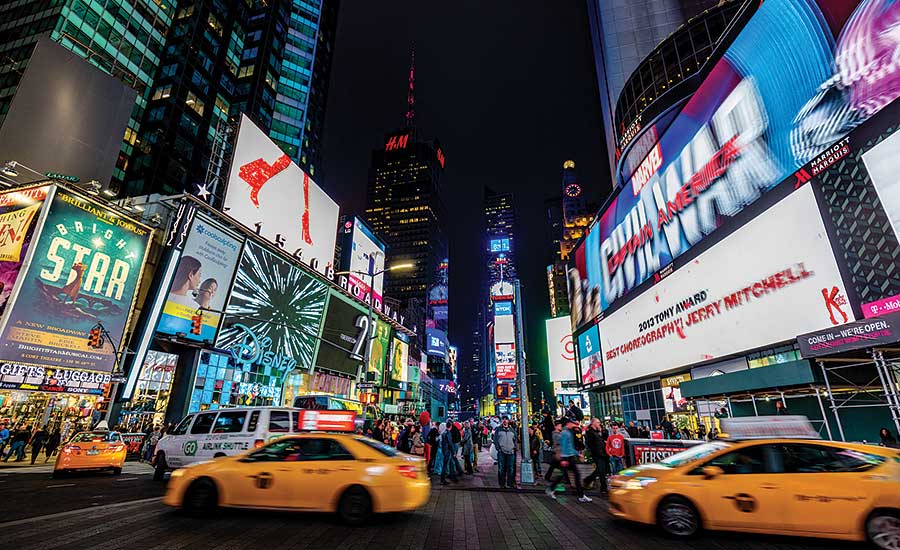A few days ago I was driving on the Pennsylvania Turnpike in a daylight downpour. Black clouds hung low and visibility was poor. Windshield wipers flashed furiously. Passing cars and trucks kicked up jet streams of rain water. Then I noticed a series of bright, crisp, digital billboards flashing display ads. The dark, misty highway made the digital boards hard to ignore. They are also visible from a greater distance. You notice them sooner. Which of course is the point of outdoor advertising.
But I thought, this seems like another form of distracted driving. I kept glancing over at the signs, curious about what they would show next; also I was drawn to their glaring brightness, and sometimes my sideways glances last longer if I tried to make out the small words in the message.
According to research…
I decided to research the dangers of digital billboards. This is what I learned:
- 6,400 digital billboards currently dot American roadways, according to the Outdoor Advertising Association of America
- Digital billboards are the future, steadily growing in number despite opposition from some community activists and legal efforts in cities such as Los Angeles to limit or ban them.
- When a driver glances two seconds or longer at a “distracting agent” his or her potential exposure to a crash goes up. Especially in bad weather and heavy, rush hour traffic. A 2006 study by Virginia Tech for the National Highway Traffic Safety Administration confirmed that anything that diverts a driver’s eyes off the road for more than two seconds greatly increases the risk of a crash. The study found 80 percent of all crashes involved driver inattention just prior to (within three seconds) of the crash.
- Texting, of course is the most alarming distraction. Sending or reading a text takes your eyes off the road for five seconds.
- Research into the safety of digital billboards presents conflicting findings. The $7 billion outdoor sign industry likes to point to a 2013 federal study that concluded digital billboards were not distracting. The federal assessment said the longest recorded glance at an electronic billboard was 1.34 seconds.
- But government-funded research on the impact of 18 digital billboards along high-speed roadways in Alabama and Florida found crash rates 25 percent to 28 percent higher near the signs than at control sites down the road. Many of the crashes were rear-end collisions or sideswipes.
- A study by the Swedish National Road and Transport Research Institute found that drivers look at digital billboards significantly longer than they do at other “passive” signs on the same stretch of road. A Massachusetts study found that older motorists in particular were prone to glance at digital billboards as they changed messages.
- Electronic billboards change messages about every eight seconds. Every eight seconds means 450 commercials every hour, or more than 10,000 flashing messages every day.
- Many states have laws against texting, talking on a cell phone, and other distractions while driving. Every day, more than eight people are killed and 1,161 injured in crashes reportedly involving a distracted driver. In 2015, 3,477 people were killed and 391,000 injured in crashes involving distracted drivers.
- Digital billboards, with their conflicting safety-related research, are less regulated. Four states – Vermont, Maine, Alaska and Hawaii permit no billboards, digital or static. About 90 percent of Texas cities do not permit digital billboards.
Make your drivers aware
Ninety percent of Americans drive to work every day, according to the Brookings Institute. Americans spend 175 billion hours in transit, which averages out to about 100 minutes per day for each and every American. And most workers (76.1 percent) drive to work alone. Meaning there is no passenger or “coach” to observe and give immediate feedback on distracted driving practices, including frequent glances at those bright, digital, flashing message boards.
With so many employees on the road every day, for upwards of two hours, and with so many potential distractions both inside and outside vehicles, companies should alert workers to related laws, just how quickly crashes caused by distractions occur, the types of distractions, and the grim annual toll distracted driving produces in terms of deaths and injuries.
You might also want to mention the growing prevalence of digital billboards and the conflicting research surrounding their safety. Mention that context is an important risk factor – digital billboards can be more of risk in bad weather and heavy traffic, for example, and on high-speed roadways. Drivers should also know the risk of any glance off the road longer than two seconds, which is something of a safety benchmark. And they should know the potential exists for digital billboards to keep up a driver’s curiosity over an extended period of time, and that drivers are hardwired to notice bright, changing lights in their peripheral vision and to anticipate additional motion. Awareness is the first step.






